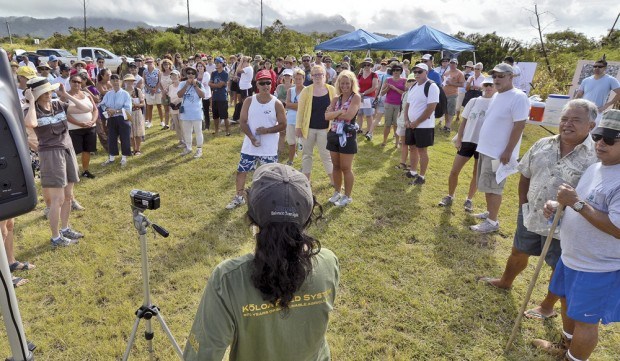KOLOA — “Today, we relive the days of Hapa Road,” Koloa resident Teddy Blake said in welcoming about a hundred people who turned out for the Hapa Road Walk, one of the inaugural events for the nine-day Koloa Plantation Days
KOLOA — “Today, we relive the days of Hapa Road,” Koloa resident Teddy Blake said in welcoming about a hundred people who turned out for the Hapa Road Walk, one of the inaugural events for the nine-day Koloa Plantation Days celebration.
Teddy, whose brother Hartwell performed the welcoming pule, said the Saturday walk was dedicated to Carlos Buhk and Joe Kuala, owner of Progressive Expressions, whom he credits as being the sparkplugs of a pro-active approach to Hapa Trail in 2008.
“They would come out every day for more than three months and drag us with them,” Teddy said. “They started at 6:30 a.m. and would end around 8:30 a.m. before the Koloa sun became too hot.”
This effort cleared Hapa Trail of the koa haole, cacti with large thorns, crawling night blooming cereus and invasive guinea grass. The work also unveiled some of the history of Koloa Hema, or the South Shore.
“This is the real deal,” Teddy said. “This is a Polynesian culture center and we didn’t need to build it. It’s already here, covering some 26 heiau and several key archeological sites.”
One of those facets was the Koloa Field System which is lauded on the back of the 2011 edition of the Hapa Road commemorative t-shirts.
“Water came from mauka, or mountain-side, and collected in the Waikomo Stream,” Teddy said, simplifying the complex irrigation system for the benefit of time. “With more than 100 miles of ‘auwai, or irrigation system, it sent water to irrigate more than 2,000 acres of crops.”
Teddy said this same land was classified by the U.S. Soil Conservation Service as being unsuitable for agriculture, but the Koloa system thrived for more than 500 years before its demise by the start of the sugar industry which diverted its water. By comparison, the sugar industry enjoyed a 167-year legacy.
Combined with Kaua‘i’s first Royal Port of Entry, Hanaka‘ape Bay, known today as Koloa Landing, sweet potatoes were shipped to California during the California Gold Rush and sugar to the North during the Civil War. Hanaka‘ape Bay was the third busiest port in the Kingdom of Hawai‘i due to its fresh water (Waikomo Stream) and abundance of products being produced.
More historical anecdotes are available during the approximately two-hour Makawehi Sand Dune Walk which starts at 9 a.m. Monday from the Seaview Terrace at the Grand Hyatt Kaua‘i Resort and Spa.
That evening, Kukui‘ula Village hosts the historic film night and exhibit starting at 6 p.m.
The nine-day Koloa Plantation Days celebration climaxes with the parade and ho‘olaule‘a, Saturday.
Today’s events include a family fun run/walk that starts at 7 a.m. at Po‘ipu Beach Park; a charity tennis tournament at 8 a.m. at Po‘ipu Kai; a miniature golf tournament at 10 a.m. at Lawa‘i Beach Resort; and the 12th annual Plantation Days Rodeo at 11 a.m. at CJM Stables.
Visit www.koloaplantationdays.com or refer to the program guide in last Wednesday’s edition of The Garden Island for more information.
• Dennis Fujimoto, photographer and staff writer, can be reached at 245-3681 (ext. 253) or dfujimoto@ thegardenisland.com.


